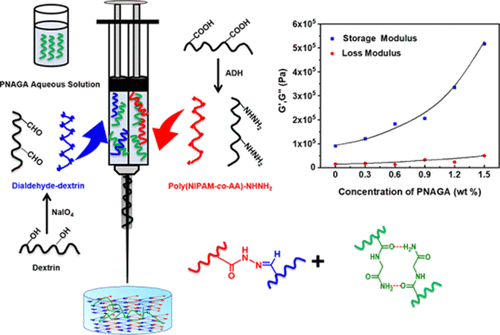当前位置:
X-MOL 学术
›
ACS Appl. Polym. Mater.
›
论文详情
Our official English website, www.x-mol.net, welcomes your
feedback! (Note: you will need to create a separate account there.)
Hydrogen-Bonding Reinforced Injectable Hydrogels: Application As a Thermo-Triggered Drug Controlled-Release System
ACS Applied Polymer Materials ( IF 4.4 ) Pub Date : 2020-03-23 , DOI: 10.1021/acsapm.9b01232 Dong Wang 1 , Yuzheng Xia 1 , Dong Zhang 1 , Xiaomeng Sun 1 , Xiaonong Chen 1 , Susan Oliver 2 , Shuxian Shi 1 , Lei Lei 2
ACS Applied Polymer Materials ( IF 4.4 ) Pub Date : 2020-03-23 , DOI: 10.1021/acsapm.9b01232 Dong Wang 1 , Yuzheng Xia 1 , Dong Zhang 1 , Xiaomeng Sun 1 , Xiaonong Chen 1 , Susan Oliver 2 , Shuxian Shi 1 , Lei Lei 2
Affiliation

|
Most injectable hydrogels are prone to irreversible deformation or damage under sustained shear forces and exhibit low mechanical properties, which limit their practical applications in biological engineering. In this work, the first hydrogen-bonding reinforced injectable thermoresponsive hydrogel system has been fabricated through an in situ hydrazide–aldehyde cross-linking reaction between hydrazide-functionalized poly(N-isopropylacrylamide) (PNIPAM) and dialdehyde dextrin. The mechanical strength and stability of the hydrogel were reinforced by the introduction of intermolecular hydrogen-bonding from poly(N-acryloyl glycinamide) (PNAGA), which possesses great biocompatibility and similarity to PNIPAM. The internal morphology, dynamic moduli, de-cross-linking properties, and temperature responsiveness of the hydrogels were systematically investigated. Upon hydrogen-bonding reinforcement, the hydrogel elasticity, reflected by the maximum storage modulus, dramatically increased from 90.2 to 517.0 kPa, which is about a 570% increase compared with unreinforced hydrogels. In addition, the mechanical properties of the hydrogel were reinforced as the de-cross-linking could be inhibited by PNAGA-based hydrogen-bonding. The temperature release behavior of the hydrogel was assessed with a model drug (propranolol hydrochloride, PHCl) and could be precisely controlled by adjusting the environmental temperature between 25 and 37 °C. Therefore, PNAGA reinforced thermoresponsive hydrogels are promising functional biological materials for use in tissue-repair engineering and controlled-release drug delivery.
中文翻译:

氢键增强可注射水凝胶:作为热触发药物控制释放系统的应用
大多数可注射的水凝胶在持续的剪切力作用下易于发生不可逆的变形或损坏,并且机械性能低,这限制了它们在生物工程中的实际应用。在这项工作中,通过在酰肼官能化的聚(N-异丙基丙烯酰胺)(PNIPAM)和二醛糊精之间进行的酰肼-醛交联反应,制备了第一个氢键增强的可注射热敏水凝胶体系。通过从聚(N)引入分子间氢键,增强了水凝胶的机械强度和稳定性。-丙烯酰甘氨酰胺)(PNAGA),具有很大的生物相容性,与PNIPAM具有相似性。系统地研究了水凝胶的内部形态,动态模量,去交联性质和温度响应性。氢键增强后,最大储能模量反映出的水凝胶弹性从90.2 kPa显着增加到517.0 kPa,与未增强的水凝胶相比,增加了约570%。此外,由于可以通过基于PNAGA的氢键抑制去交联,从而增强了水凝胶的机械性能。用模型药物(盐酸普萘洛尔,PHCl)评估了水凝胶的温度释放行为,可以通过在25至37°C之间调节环境温度来精确控制水凝胶的释放温度。因此,
更新日期:2020-04-23
中文翻译:

氢键增强可注射水凝胶:作为热触发药物控制释放系统的应用
大多数可注射的水凝胶在持续的剪切力作用下易于发生不可逆的变形或损坏,并且机械性能低,这限制了它们在生物工程中的实际应用。在这项工作中,通过在酰肼官能化的聚(N-异丙基丙烯酰胺)(PNIPAM)和二醛糊精之间进行的酰肼-醛交联反应,制备了第一个氢键增强的可注射热敏水凝胶体系。通过从聚(N)引入分子间氢键,增强了水凝胶的机械强度和稳定性。-丙烯酰甘氨酰胺)(PNAGA),具有很大的生物相容性,与PNIPAM具有相似性。系统地研究了水凝胶的内部形态,动态模量,去交联性质和温度响应性。氢键增强后,最大储能模量反映出的水凝胶弹性从90.2 kPa显着增加到517.0 kPa,与未增强的水凝胶相比,增加了约570%。此外,由于可以通过基于PNAGA的氢键抑制去交联,从而增强了水凝胶的机械性能。用模型药物(盐酸普萘洛尔,PHCl)评估了水凝胶的温度释放行为,可以通过在25至37°C之间调节环境温度来精确控制水凝胶的释放温度。因此,











































 京公网安备 11010802027423号
京公网安备 11010802027423号